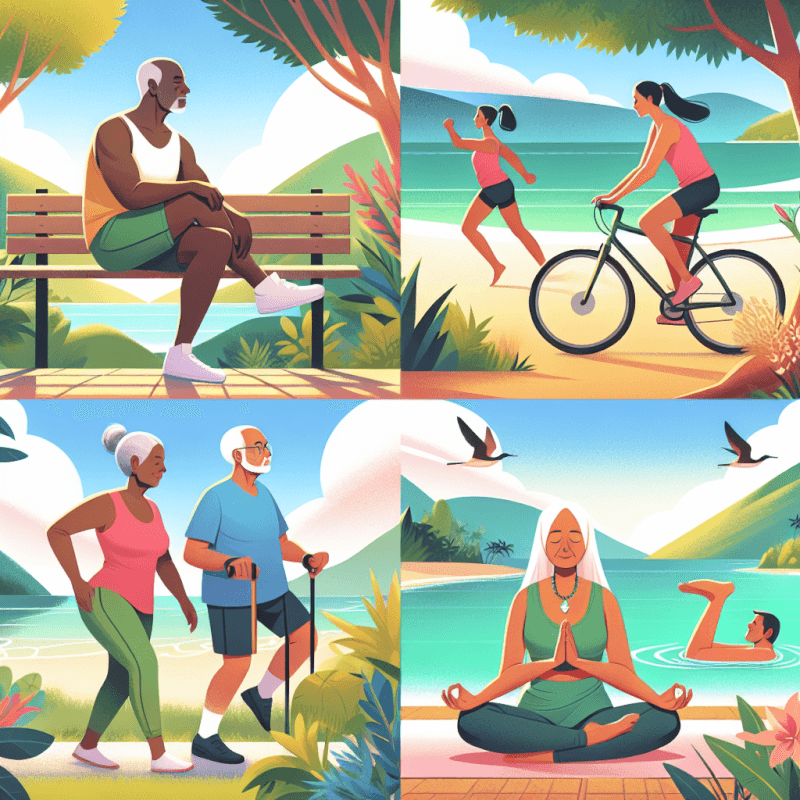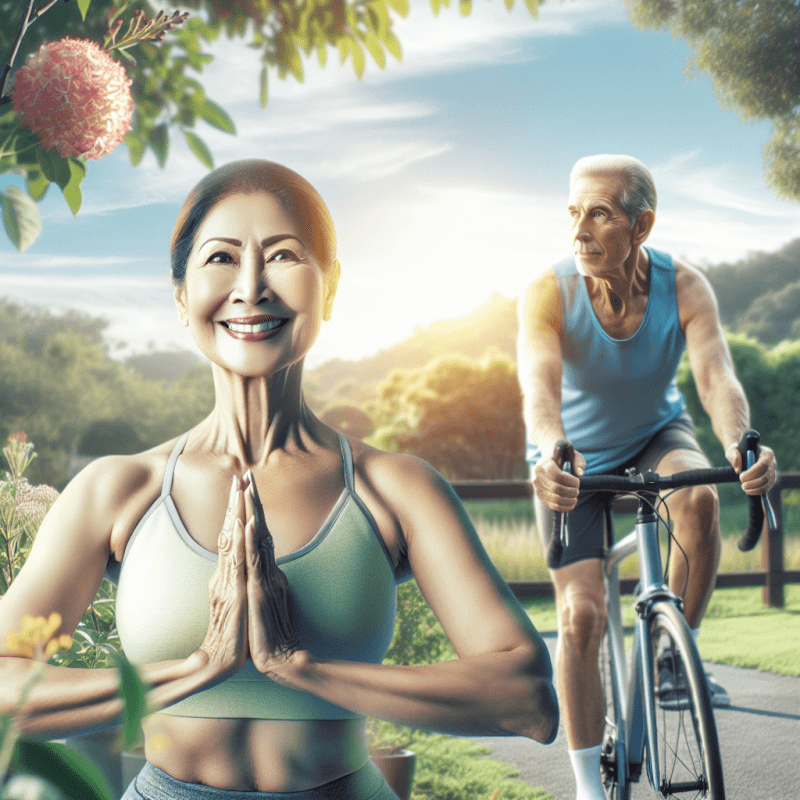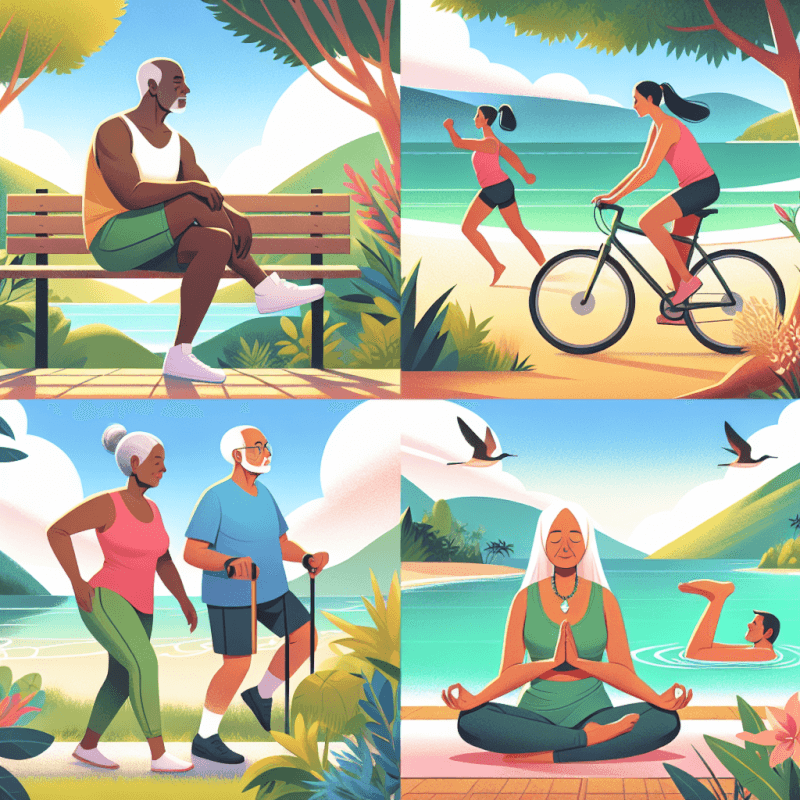Are you over 50 and looking for a simple yet effective daily workout routine? Look no further! In this article, we have curated an easy-to-follow workout plan specifically designed for individuals in their golden years. Whether you’re a seasoned fitness enthusiast or just starting out, this daily workout regimen will help you stay active, increase flexibility, and maintain a healthy lifestyle. So get ready to prioritize your well-being and achieve your fitness goals, one exercise at a time.

Cardiovascular Exercises
Walking
Walking is a fantastic cardiovascular exercise that is accessible to people of all fitness levels, including those over 50. It is low-impact, gentle on the joints, and can be done anywhere, making it a convenient and effective way to get your heart rate up. Whether you choose to walk outdoors in nature or on a treadmill in the comfort of your own home, walking regularly can help improve your cardiovascular health, increase your stamina, and contribute to weight management.
Cycling
Cycling is another great cardiovascular exercise option for individuals over 50. Whether you prefer cycling outdoors or using a stationary bike, this form of exercise helps to strengthen your heart, lungs, and lower body muscles. Cycling is also a low-impact exercise that is gentle on the joints, making it an excellent choice for those with joint issues or arthritis. Additionally, cycling can be a fun and enjoyable activity to incorporate into your daily routine.
Swimming
Swimming is a fantastic full-body workout that is gentle on the joints and suitable for individuals of all fitness levels. The buoyancy of water reduces the impact on your joints, making swimming an ideal cardiovascular exercise for aging adults. It not only increases your heart rate but also engages all major muscle groups, providing an excellent resistance workout. Swimming regularly can help improve cardiovascular health, increase strength and flexibility, and promote overall well-being.
Dancing
Don’t underestimate the power of dancing when it comes to cardiovascular exercise for those over 50. Not only is dancing a fun and enjoyable activity, but it also offers numerous health benefits. Whether you choose to join a dance class, groove to your favorite tunes in the comfort of your living room, or go out dancing with friends, dancing gets your heart rate up and increases endurance. It not only improves cardiovascular health but also helps with coordination, balance, and muscle strength.
Strength Training
Resistance Band Exercises
Resistance bands are a versatile and affordable tool for strength training, especially for individuals over 50. They provide a safe and effective way to build muscular strength, improve balance, and increase flexibility. Resistance band exercises target all major muscle groups, allowing you to customize your routine based on your individual needs and goals. Whether you’re a beginner or an experienced exerciser, resistance band exercises are easily modified to suit your fitness level.
Dumbbell Exercises
Dumbbells are excellent for strength training and can be easily incorporated into your daily workout routine. They offer a wide range of exercises that target different muscle groups, helping you build muscle strength and improve bone density. Dumbbell exercises can be done at the gym or in the comfort of your own home, making them a convenient option for individuals over 50. Start with lighter weights and gradually increase as you become stronger and more comfortable with the exercises.
Bodyweight Exercises
Bodyweight exercises are an effective way to improve strength, flexibility, and balance without the need for any equipment. They can be done anywhere, making them an excellent choice for individuals over 50 who may not have access to a gym or prefer to work out at home. Bodyweight exercises such as squats, lunges, push-ups, and planks engage multiple muscle groups and provide a challenging workout. They can be modified to suit your fitness level and gradually progressed as your strength improves.
Yoga
Yoga is a holistic exercise that combines strength, flexibility, balance, and mindfulness. It is a popular choice among individuals over 50 due to its gentle nature and numerous health benefits. Yoga not only strengthens the body but also promotes relaxation and reduces stress. It improves flexibility, balance, and posture, while also enhancing body awareness and promoting a sense of well-being. Whether you prefer a gentle restorative yoga class or a more vigorous vinyasa flow, there are yoga styles and classes available for all fitness levels.
Flexibility and Balance
Stretching
Stretching is an essential component of any fitness routine, particularly for individuals over 50. It helps improve flexibility, increase range of motion, and prevent injuries. Regular stretching can help alleviate muscle tightness, reduce joint stiffness, and improve posture. Incorporating stretching exercises into your daily workout routine can help maintain and improve your flexibility, allowing you to move with ease and grace.
Tai Chi
Tai Chi is a gentle, low-impact exercise that combines slow, flowing movements with deep breathing and mindfulness. It originated as a martial art and is now widely practiced for its numerous health benefits. Tai Chi improves flexibility, balance, and coordination while reducing stress and promoting relaxation. It is often referred to as “meditation in motion” and is suitable for individuals of all fitness levels, including those over 50.
Pilates
Pilates is a low-impact exercise method that focuses on core strength, flexibility, and body alignment. It incorporates controlled movements and emphasizes breath control and body awareness. Pilates exercises target the deep muscles of the abdomen, lower back, hips, and pelvis, helping improve stability, posture, and overall body strength. Whether you prefer mat-based or equipment-based Pilates, this form of exercise can be tailored to meet individual needs and goals.
Warm-up and Cool-down
Light Cardio
Before diving into your main workout, it’s essential to warm up your body with some light cardio exercises. This can include brisk walking, gentle cycling, or using an elliptical machine for a few minutes. The purpose of a warm-up is to gradually elevate your heart rate, increase blood flow to your muscles, and prepare your body for exercise. By warming up, you reduce the risk of injury and enhance your overall performance during the workout.
Joint Mobility Exercises
Joint mobility exercises are crucial for individuals over 50 as they help maintain and improve joint function, flexibility, and range of motion. These exercises focus on gently moving the joints through their full range of motion to reduce stiffness and increase mobility. Examples of joint mobility exercises include shoulder circles, wrist rotations, ankle circles, and neck stretches. Incorporating these exercises into your warm-up routine can help improve joint health and prevent injuries.
Stretching
After completing your workout, taking the time to cool down and stretch is just as important as warming up. Stretching exercises during the cool-down phase help reduce muscle soreness and prevent stiffness. They also promote flexibility and help bring your heart rate and breathing back to normal. Include stretches for all major muscle groups, holding each stretch for 15-30 seconds while focusing on deep breathing and relaxation. Make sure to listen to your body and stretch until you feel a gentle pull. Avoid bouncing or forcing yourself into painful stretches.

Choosing the Right Intensity
Low to Moderate Intensity
Low to moderate-intensity workouts are generally safe and suitable for most individuals over 50, including beginners. These workouts involve activities that increase your heart rate and breathing but allow you to carry on a conversation comfortably. Examples of low to moderate-intensity exercises include brisk walking, leisurely cycling, and water aerobics. Engaging in these types of exercises for at least 150 minutes per week can help improve cardiovascular health and stamina.
High Intensity Interval Training (HIIT) modified for older adults
High-intensity interval training (HIIT) has gained popularity in recent years for its efficiency and effectiveness. While HIIT can be intense for individuals over 50, it can be modified to suit their needs. The key is to start slowly and gradually increase the intensity and duration of the intervals. For example, instead of sprinting, you might try a brisk walk or a moderate jog followed by a period of rest. HIIT can be an excellent way to challenge yourself, improve cardiovascular fitness, and burn calories in a shorter amount of time.
Safety Precautions
Consult with a Healthcare Professional
Before starting any new exercise program, especially if you’re over 50, it’s essential to consult with a healthcare professional, such as your doctor or a qualified fitness instructor. They can assess your current health and fitness level, provide recommendations, and help you determine the appropriate exercises and intensity for your individual needs. This is particularly important if you have any pre-existing medical conditions or concerns.
Listen to Your Body
Listen to your body and pay attention to any signs of discomfort or pain during exercise. It’s essential to differentiate between muscle fatigue, which is normal, and sharp or prolonged pain, which may indicate an injury. If something doesn’t feel right, modify the exercise or stop altogether. Pushing through pain can lead to further damage and hinder your progress. Always prioritize your safety, and if in doubt, seek advice from a qualified professional.
Start Slow and Gradually Increase Intensity
When starting a new exercise program, especially if you’re over 50, it’s crucial to start slow and gradually increase the intensity and duration of your workouts. This allows your body to adapt and reduces the risk of injury. Begin with shorter exercise sessions and lower intensities, focusing on proper form and technique. As your fitness level improves, gradually progress by increasing workout duration, intensity, or adding new exercises to challenge yourself.
Use Proper Equipment and Gear
Using appropriate equipment and gear is essential for your safety and the effectiveness of your workouts. Invest in supportive and comfortable footwear, especially if you’re engaging in weight-bearing or high-impact activities. Use proper clothing that allows for freedom of movement and wicks away sweat. If using equipment such as resistance bands or dumbbells, ensure they are in good condition and suitable for your fitness level.

Modifying Exercises for Individual Needs
Joint Issues
If you have joint issues, it’s important to modify exercises to reduce stress on the joints while still engaging the targeted muscles. For example, if you have knee issues, you may want to choose low-impact exercises like swimming or cycling instead of high-impact activities like running. It’s also helpful to avoid exercises that exacerbate your joint pain and focus on exercises that improve joint mobility, such as gentle stretching and joint mobility exercises.
Balance Problems
Balance can become a concern as we age, but there are exercises that can help improve balance and stability. Incorporating exercises like Tai Chi, yoga, and Pilates into your routine can be beneficial for enhancing balance. Additionally, performing exercises that target core strength and lower body stability, such as single-leg exercises or balance boards, can help improve balance and reduce the risk of falls.
Cardiovascular Health Concerns
If you have cardiovascular health concerns, it’s crucial to work closely with your healthcare professional to determine the appropriate intensity and duration of your workouts. They may recommend low to moderate-intensity exercises like walking, swimming, or cycling. Regular monitoring of heart rate and blood pressure during exercise can also provide useful information and ensure you’re exercising within safe limits.
Strength Limitations
If you have strength limitations, it’s important to start with exercises that are appropriate for your fitness level and gradually increase the intensity as your strength improves. Resistance band exercises, bodyweight exercises, and gentle dumbbell exercises can be great options for building strength without overwhelming your muscles. Adjusting the weight, repetitions, or sets of the exercises can help tailor the workout to your individual needs and capabilities.
Incorporating Variety
Try Different Workouts
To keep your workouts interesting and maintain your motivation, it’s beneficial to try different types of exercises and workouts. This not only prevents boredom but also allows you to target different muscle groups and challenge your body in new ways. Mix up your routine by including cardiovascular exercises like walking and cycling, strength training exercises using resistance bands or dumbbells, and flexibility and balance exercises like yoga or Tai Chi. Exploring different workouts can help you discover new activities that you enjoy and keep you excited about exercising.
Join Fitness Classes
Joining fitness classes is a great way to engage in structured workouts and connect with like-minded individuals. Many gyms and community centers offer a variety of fitness classes specifically designed for older adults, such as aerobics, dance, yoga, and strength training. These classes provide professional guidance, camaraderie, and a fun and supportive environment to stay motivated and accountable.
Outdoor Activities
Take advantage of the great outdoors and incorporate outdoor activities into your exercise routine. Walking or jogging in nature, cycling through scenic routes, hiking, or participating in outdoor sports like golf or tennis can make exercising more enjoyable and refreshing. Outdoor activities not only provide physical benefits but also allow you to connect with nature, reduce stress, and improve mental well-being.
Sports and Recreational Activities
Engaging in sports and recreational activities is an excellent way to stay active and have fun. Whether it’s playing basketball, swimming, dancing, or playing golf, participating in sports can provide a fulfilling and competitive outlet. Look for local leagues or clubs that offer opportunities for older adults to join and play various sports. Playing with others adds a social aspect to your workouts and can contribute to maintaining a healthy and active lifestyle.

Benefits of Daily Workouts for Over 50
Improved Cardiovascular Health
Engaging in regular cardiovascular exercise has numerous benefits for individuals over 50. It helps strengthen the heart, lower blood pressure, improve circulation, and reduce the risk of heart disease. Regular aerobic exercise also boosts overall stamina and endurance, making everyday activities easier and more enjoyable. By incorporating cardiovascular exercises like walking, cycling, swimming, or dancing into your routine, you can significantly improve your cardiovascular health and enhance your quality of life.
Increased Muscle Strength and Bone Density
Strength training exercises are particularly important for individuals over 50, as muscle mass naturally declines with age. Regular strength training helps increase muscle strength and tone, supporting joint health, improving overall function, and reducing the risk of falls and fractures. Strength training also promotes bone density, reducing the risk of osteoporosis and maintaining skeletal health. By incorporating resistance band exercises, dumbbell exercises, bodyweight exercises, or yoga into your routine, you can build and maintain strong muscles and bones.
Enhanced Flexibility and Balance
Flexibility and balance are essential components of functional fitness, particularly for older adults. As we age, our joints tend to stiffen, and balance can become compromised. Regular stretching, yoga, and Pilates can help improve flexibility, increase range of motion, and alleviate muscle tightness. Similarly, exercises like Tai Chi, yoga, and Pilates can enhance balance and stability, reducing the risk of falls and injuries. By incorporating flexibility and balance exercises into your routine, you can maintain a full range of motion, move with ease, and improve overall physical performance.
Boosted Mood and Mental Health
Exercise has been shown to have a tremendous positive impact on mental health and well-being. Engaging in daily workouts can help reduce stress, enhance mood, and improve overall mental well-being. Physical activity stimulates the release of endorphins, also known as the “feel-good” hormones, which can boost mood and alleviate symptoms of depression and anxiety. Regular exercise also improves cognitive function, enhances memory, and promotes better sleep. By making daily workouts a priority, you can experience these mental health benefits and enjoy a higher quality of life.
Staying Motivated
Set Realistic Goals
Setting realistic goals is essential to stay motivated and track your progress. Start by identifying what you want to achieve with your exercise routine. Whether it’s improving cardiovascular health, increasing strength, losing weight, or enhancing flexibility, setting specific and achievable goals helps provide focus and direction. Break these goals down into smaller, measurable milestones and celebrate each milestone as you progress. Remember, consistency and patience are key, so don’t be too hard on yourself if progress is gradual.
Find a Workout Buddy
Exercising with a friend or finding a workout buddy can make your workouts more enjoyable and keep you accountable. A workout buddy can provide support, motivation, and friendly competition. They can be the extra push you need to get out of bed in the morning or the encouragement to push through challenging workouts. Whether it’s a friend, family member, or joining a fitness group, having someone to share your fitness journey with can make the experience more rewarding.
Reward Yourself
Rewarding yourself for reaching milestones or sticking to your exercise routine can be a great way to stay motivated. Find ways to treat yourself that align with your health and fitness goals. It could be buying a new workout outfit, treating yourself to a massage, or taking a relaxing spa day. Having something to look forward to can help you stay on track and maintain a positive mindset throughout your fitness journey.
Track Your Progress
Keeping track of your progress is an excellent way to stay motivated and see how far you’ve come. Whether it’s monitoring your steps, tracking your workouts in a journal, or using fitness apps and wearable devices, having tangible evidence of your improvements can be incredibly rewarding. Celebrate each milestone you achieve, whether it’s running a longer distance, lifting heavier weights, or improving your flexibility. Recognizing your progress is a powerful motivator, encouraging you to keep pushing yourself and reaching new goals.
In conclusion, engaging in a daily workout routine is incredibly beneficial for individuals over 50. By incorporating a combination of cardiovascular exercises, strength training, flexibility and balance exercises, and prioritizing warm-up and cool-down routines, you can enjoy improved overall health and well-being. It’s important to choose exercises that align with your individual needs, follow safety precautions, and modify workouts as necessary. By staying motivated, setting realistic goals, and finding activities you enjoy, you can make daily exercise a sustainable and enjoyable part of your lifestyle. So lace up your shoes, grab your resistance bands or dumbbells, and get moving – your body and mind will thank you!



